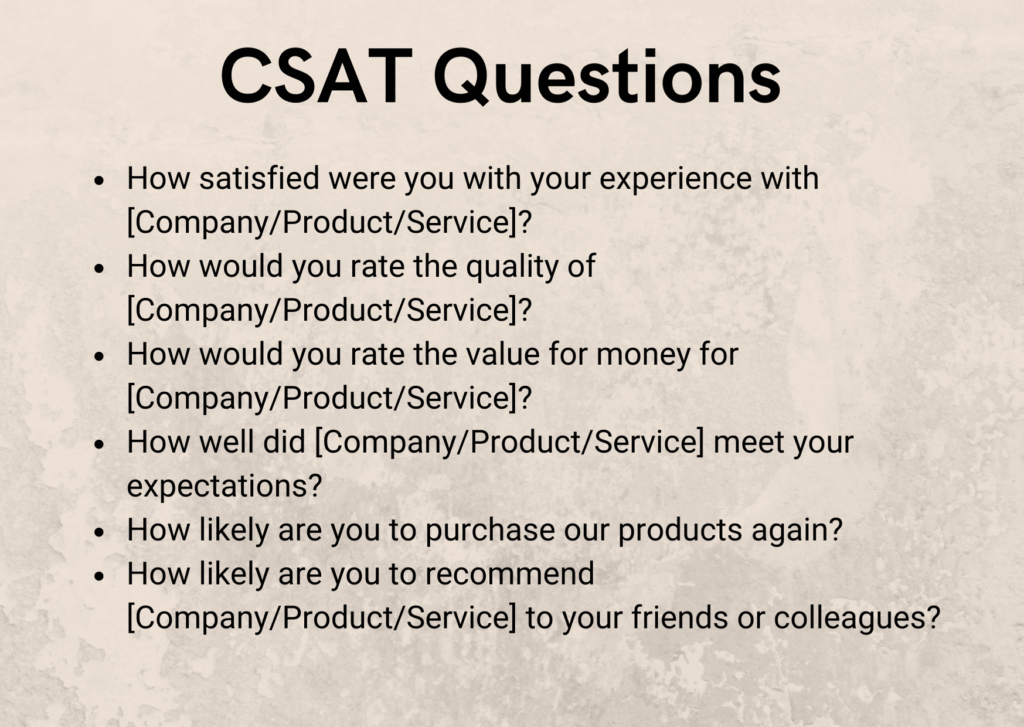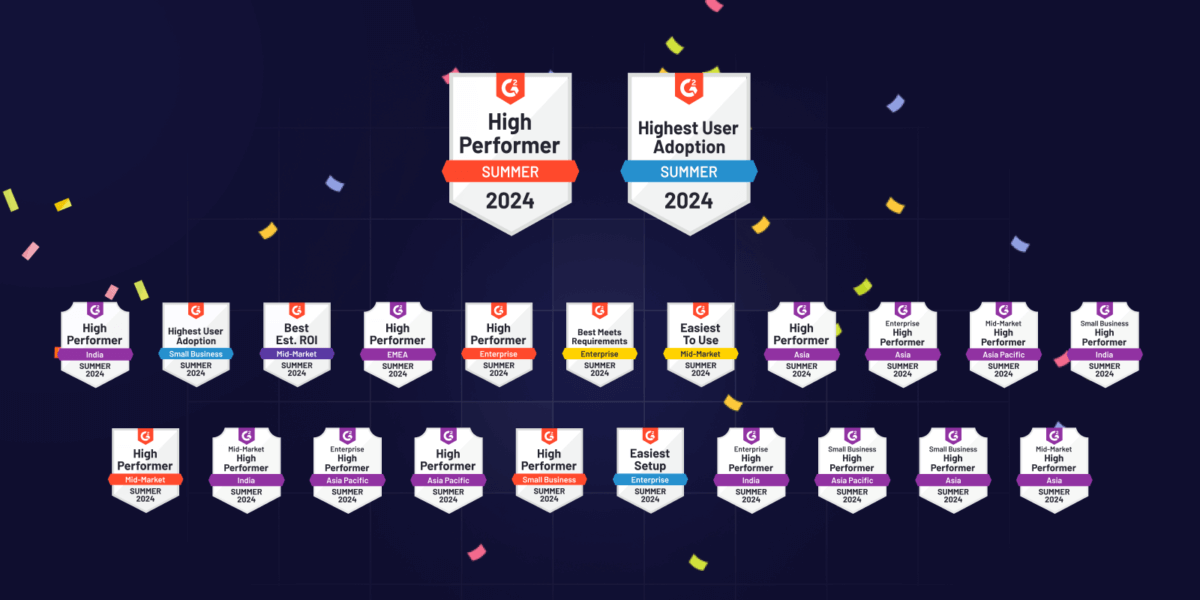CSAT: The Ultimate Guide and 2025 Benchmark
- June 9th, 2025 / 8 Mins read
-
Aarti Nair

CSAT: The Ultimate Guide and 2025 Benchmark
- June 9th, 2025 / 8 Mins read
-
Aarti Nair
Let’s say a customer receives a delayed product, reaches out to your support team, and ends the interaction feeling unheard and frustrated. What happens next? Most likely, they won’t come back.
In fact, over 50% of customers switch to a competitor after just one bad experience.
This is exactly why Customer Satisfaction Scores (CSAT) matter. CSAT helps you measure how satisfied your customers are after interacting with your business — whether it’s a purchase, a support call, or even a simple website visit. It gives you real-time feedback on what’s working and what’s driving people away.
And businesses are taking notice:
-
80% of companies use CSAT scores to monitor and improve customer experience.
-
90% have made customer experience (CX) their top priority.
And those who focus on CX?
They’ve seen up to an 80% increase in revenue.
In this guide, we’ll break down what a CSAT score is, why it matters, and how your business can use it to improve customer experience, drive loyalty, and boost growth — one satisfied customer at a time.
We cover the following topics:
- Why is Customer Satisfaction Score Important?
- What is a CSAT Score?
- How to Calculate CSAT Score? Methodology
- 1. Composite Customer Satisfaction Score
- 2. Top-2-Box Method.
- What Questions to Ask to Measure CSAT? (CSAT Questions)
- Use Cases
- 1. Customer Complaints
- 2. Prevent Churn and Improve Retention
- 3. Product Development
- 4. Customer Loyalty
- CSAT Score Pros and Cons
- How to Improve CSAT Scores using Chatbots?
- Alternatives
- 1. Net promoter score
- 2. Customer Effort Score
What is a CSAT score and why is it important? Let’s start off with the first big question.
Why is Customer Satisfaction Score Important?
In a market where competition is high and customer loyalty is fragile, understanding how your customers feel is no longer optional — it’s essential.
Customer Satisfaction Score (CSAT) is one of the most direct ways to measure whether your business is meeting customer expectations. It gives you a clear, quantifiable view of how satisfied customers are after an interaction — whether it’s a support call, a product delivery, or a website experience.
Research by Frederick Reichheld of Bain & Company has shown that an increase in customer retention of 5% can increase a company's profits by anywhere between 25% to 95%.
You may not know who Frederick Reichheld is, but the spirit behind his research is universally understood.
Happy customers are great for businesses.
And when you see what satisfied customers mean for your bottom line, it’s easy to see why.
Existing customers who aren’t subjected to high-effort purchase experiences have been shown to:
- Buy more (higher cart values)
- Buy more often (more frequently)
- Close more (60%-70% chance vs 5%-20% for a prospect)
- Close quicker (in lesser time)
- Spend more (33% more per purchase) and
- Save you money (low acquisition costs)
Here’s why CSAT matters for your business:
1. It Helps You Spot Problems Early
A low CSAT score is often the first sign that something’s gone wrong. Whether it’s a slow response time, a confusing process, or a product issue, CSAT alerts you in real time — so you can fix it before it costs you a customer.
2. It Drives Customer Retention
Happy customers are more likely to return.
Unhappy ones?
70% of the customer’s journey is based on how they feel they’re being treated (McKinsey). That means even a small lapse in service can impact your bottom line.
3. It Builds Trust
Trust is the foundation of customer loyalty. Nearly 90% of customers say they trust a company whose service they rate as “very good”, while just 16% feel the same about companies with poor service ratings (Qualtrics XM Institute). CSAT gives you the insight to build that trust consistently.
4. It Guides Business Decisions
CSAT data helps you prioritise improvements. Whether it’s refining your support scripts, retraining agents, or fixing a recurring product issue, decisions backed by customer feedback are far more effective.
5. It Aligns Teams Around a Common Goal
When you measure CSAT, every team — from support to product to marketing — can rally around one shared goal: making the customer experience better.
Providing support in a manner that prioritizes customer satisfaction is key.
Companies have started to move away from traditional support tools like phone calls, emails, and tickets. Chatbots and Live Chat have become the new norm.
But measuring something as subjective as “satisfaction” is challenging.
There are just so many types of satisfaction surveys that choosing between them can be daunting.
The three major metrics for Customer Satisfaction are
- NPS (Net Promoter Score),
- CES (Customer Effort Score), and
- CSAT (Customer Satisfaction Score).
Suggested Reading: Customer Support Metrics to Track and How to Improve Them
What is a CSAT Score?
CSAT, or Customer Satisfaction Score, is a key metric used to measure how satisfied customers are with a specific interaction, product, or service. It’s one of the simplest and most widely used ways to track customer experience.
Here’s how it works:
After a customer interacts with your business — for example, after speaking with a support agent or completing a purchase — they’re prompted with a short question like:
“How satisfied were you with your experience?”
Customers typically respond using a rating scale, such as:
-
1 to 5 (where 1 = very unsatisfied and 5 = very satisfied), or
-
Emoji or star ratings
-
Yes/No options (in simpler setups)
Definition of CSAT
The Customer Satisfaction Score is one of the most straightforward survey methodologies. It is used to measure customer satisfaction with a business, purchase or interaction.
It is calculated by asking customers a question and having them answer on a scale.
Methodology of CSAT Calculation
There are two primary methods of calculating a CSAT score.
I. Composite Customer Satisfaction Score
Assume a question, as follow.
“How would you rate your satisfaction with the service you received?”
Respondents pick out options from a predetermined scale that looks like this.
-
Very unsatisfied
-
Unsatisfied
-
Neutral
-
Satisfied
-
Very satisfied
As you can see, each answer has a numerical value attached to it.
i.e. if a customer is very satisfied, he scores the process a “5”.
If the customer is partly satisfied, he scores the process a “4”.
And so on.
Add up the sum total numerical value of the replies. Divide by the total number of responses.
If you had 7 responses with responses that looked like (4+3+5+5+5+4+3), you’d get 4.14.
The value you get is the average score of your process – a.k.a. A Composite Satisfaction Score.
II. Top-2-Box Method.
It is used to calculate the percentage total of your customers who had satisfactory experiences.
Use the following formula.
*# of Satisfied Customers (80) ----------------- # of Satisfaction Survey Responses (100) |
X 100 = % of Satisfied Customers (80%) |
*”# of satisfied customers” is calculated using ONLY the users who rated the process “4” or “5”.
By only taking into account the two highest possible response ratings, you can establish the percentile breakdown of the customers who had a favorable experience.
So, if 100 people respond to your survey, and 80 of them answer “Satisfied,” that means you’d have an 80% CSAT score.
How to Calculate CSAT Score
Calculating your Customer Satisfaction Score (CSAT) is straightforward — and it gives you instant visibility into how happy your customers are after a specific interaction or journey.
Most CSAT surveys ask a single question like:
“How satisfied were you with your experience?”
Customers respond using a rating scale, usually from 1 to 5, where:
-
1 = Very Unsatisfied
-
2 = Unsatisfied
-
3 = Neutral
-
4 = Satisfied
-
5 = Very Satisfied
To calculate your CSAT score, you only count the responses that are positive — typically ratings of 4 and 5.
CSAT Formula
CSAT Score = [(Number of Satisfied Customers (4 or 5)/Total Number of Responses)] x 100
Example
Let’s say 100 customers responded to your CSAT survey:
-
20 gave a rating of 5
-
30 gave a rating of 4
-
25 gave a rating of 3
-
15 gave a rating of 2
-
10 gave a rating of 1
You have 50 satisfied customers (ratings of 4 or 5) out of 100 total responses.
CSAT Score= [(50/100)] x 100
= 50%
So, your CSAT score is 50% — meaning half of your customers reported being satisfied with their experience.
📌 Things to Keep in Mind:
-
Only include valid responses in your calculation (ignore blanks or skipped questions).
-
The higher the CSAT score, the better. Most businesses aim for 75% or higher.
-
You can calculate CSAT for individual agents, products, services, or across your entire support team.
CSAT is simple but powerful — it tells you at a glance whether you’re meeting customer expectations, and where you need to improve.
What Questions to Ask to Measure CSAT (CSAT Questions)?
Generally, when asking questions to measure CSAT, the customer should be able to answer on a scale.
Some of the commonly asked questions from which you can gauge customer’s satisfaction scores are:

To measure Customer Satisfaction Score (CSAT) effectively, it all starts with asking the right question — at the right time.
CSAT surveys are meant to be short, direct, and easy for customers to respond to. The goal is to get quick feedback without overwhelming them.
📌 Here are some common CSAT questions businesses use:
-
“How satisfied were you with your experience today?”
This is the most common CSAT question — simple, broad, and effective. -
“How satisfied were you with the support you received?”
Great for post-interaction feedback, especially after live chat or call support. -
“Did our product/service meet your expectations?”
This question helps measure satisfaction with the offering itself, not just the interaction. -
“How would you rate your overall satisfaction with our service?”
Ideal for end-to-end journey feedback — such as after onboarding or a completed order. -
“Was your issue resolved to your satisfaction?”
Perfect for measuring satisfaction after a ticket is closed or a complaint is handled. -
“Based on your experience, how likely are you to return or recommend us?”
Although this blends slightly into NPS (Net Promoter Score), it still contributes to CSAT context.
📍 Best Practices of Designing CSAT Score
-
Keep it short: One question with a rating scale (1–5 or emojis) is ideal.
-
Ask immediately after the interaction: Real-time feedback captures emotion and intent better.
-
Use clear language: Avoid jargon. Make sure the customer understands what they’re rating.
-
Follow up if needed: A second open-ended question like “What could we have done better?” can give more context.
Asking the right CSAT questions gives you more than just a number — it reveals how your customers really feel and why.
How to Design an Effective CSAT Survey
A well-crafted CSAT survey helps you gather honest, useful feedback from your customers — without overwhelming them. Let’s break down how to design one that gets high response rates and actionable insights.
1. Keep It Simple
The best CSAT surveys are short and to the point. Customers are far more likely to respond to a one-question survey than a lengthy form.
-
Stick to one clear rating question.
-
If needed, include an optional open-ended question after they’ve responded.
-
Avoid combining CSAT with too many other metrics (like NPS or CES) in one survey — keep the purpose focused.
Why it matters: Simplicity encourages more people to respond, leading to more data and better insights.
2. Use the Right Rating Scale
Your rating scale should be easy to understand at a glance. The most common formats include:
-
1 to 5 scale: Standard and widely recognised.
(1 = Very Dissatisfied, 5 = Very Satisfied) -
Emoji or smiley faces: Visually engaging and less formal — great for mobile or app-based surveys.
-
Thumbs up/down: Best for quick, binary feedback.
-
Star ratings: Familiar in e-commerce and review sites.
Tip: Avoid overly complex scales like 1–10 unless you have a good reason — they introduce ambiguity.
3. Add a Follow-Up Question (Optional)
Once you get the satisfaction score, consider following up with a short open-ended question to capture context.
Examples:
-
“What’s the main reason for your score?”
-
“Is there anything we could’ve done better?”
Why it matters: The rating gives you the ‘what’. The comment gives you the ‘why’.
This qualitative input helps identify recurring issues, standout agents, or unexpected product gaps.
4. Personalise the Wording
Instead of sending a generic message, customise it based on the interaction the customer just had.
Examples:
-
“How satisfied were you with your recent chat with Priya?”
-
“Were you happy with how we handled your refund request?”
Why it matters: Personalised surveys feel more relevant and show customers that you’re paying attention to their specific experience — not just collecting generic data.
5. Send It at the Right Time
Timing can dramatically impact your response rates and the quality of feedback.
-
Send the CSAT survey immediately after the interaction (live chat, phone call, purchase, etc.)
-
Avoid sending surveys hours or days later when the customer has moved on
Why it matters: When you ask in the moment, customers can give more accurate and emotional responses — good or bad.
6. Optimise for Mobile
Most customer interactions — especially in retail, banking, and service industries — happen on mobile devices. Your survey should:
-
Load quickly
-
Be tap-friendly
-
Avoid tiny text or complicated layouts
Use large rating icons, short questions, and responsive formatting.
Why it matters: A clunky mobile survey can lead to drop-offs — and your most engaged users may never complete it.
7. Don’t Ask Too Often
Survey fatigue is real. If a customer sees a CSAT prompt every time they engage with your brand, they’ll likely ignore it — or worse, become annoyed.
-
Set limits on how often a customer is surveyed (e.g., once per week or once per interaction type)
-
Use triggers wisely — only survey after meaningful interactions
Why it matters: Over-surveying reduces trust and distorts your data. You want honest, considered feedback — not rushed or resentful responses.
When Is the Right Time to Send a CSAT Question?
Timing is everything when it comes to collecting accurate and meaningful customer feedback. Send your CSAT survey too early, and the customer might not have formed an opinion. Send it too late, and you risk low response rates or vague feedback.
To make the most of your Customer Satisfaction Score (CSAT) surveys, it’s important to catch customers right at the moment of experience — when their feelings, impressions, and reactions are still fresh.
Here are the best times to send a CSAT question:
1. Immediately After a Customer Interaction
This is the most common and effective moment to send a CSAT survey — whether the customer just finished a live chat, phone call, or email conversation with your support team.
Why it works: The customer can clearly recall how they were treated, how long it took, and whether their issue was resolved. This makes their feedback honest and specific.
Example:
“Thanks for chatting with us! How satisfied are you with the support you received today?”
2. After a Purchase or Transaction
If your business involves product sales, loan disbursals, or subscription sign-ups, CSAT can help you understand how smooth and satisfying the process was.
Why it works: It gives insight into the full purchase journey — from browsing to checkout to payment experience.
Example:
“How satisfied were you with your recent purchase process?”
3. After an Issue Has Been Resolved
It’s useful to check how the customer feels after a support ticket is marked as “resolved” or closed. This helps you understand if the resolution was actually effective — not just marked complete on your end.
Why it works: You capture emotional sentiment around resolution speed, tone, and overall helpfulness.
Example:
“Was your issue resolved to your satisfaction?”
4. After a Milestone or Key Moment in the Customer Journey
For longer journeys — such as onboarding, loan approvals, or software training — CSAT can be used at key stages to assess the experience so far.
Why it works: It helps gauge ongoing satisfaction and gives you a chance to course-correct before dissatisfaction grows.
Example:
“You’ve completed onboarding! How satisfied are you with your experience so far?”
5. After Using a New Feature or Service
If you’ve recently launched a new chatbot, voice support feature, or self-service portal, a quick CSAT survey can reveal how well it’s performing.
Why it works: It allows for immediate feedback on adoption and usability, helping you improve fast.
Example:
“How satisfied were you with the new self-service checkout feature?”
✨ Pro Tip:
Don’t delay!
Response rates drop the longer you wait to send the survey. Real-time feedback not only improves data accuracy but also shows customers that you care about their experience at the moment.
Use Cases of CSAT Score
One of the biggest strengths of the Customer Satisfaction Store lies in its simplicity.
It’s a quick and easy way to close the gaps that would usually exist between company action and customer reaction.
To that end, a CSAT score can be used in various situations.
Customer Complaints
Implementing a CSAT score for customer complaints is a lifesaver. It helps you identify exactly when and where a customer struggled with a problem.
In customer feedback, interactions scored a 4 or 5 are considered reliable.
Customers who’ve had an experience that they score 3 or below however need to be followed up with.
Three metrics should be tracked when using CSAT to handle customer complaints.
- The number of complaints received.
- The time it took to reach out to the customer who complained.
- The total number of complaints resolved.
Prevent Churn and Improve Retention
CSAT is a leading indicator of customer churn. More customers giving a bad CSAT rating indicate a bad experience.
Avoiding churn and retaining customers is arguably the most important factor in the growth of a business.
We’ve heard this many times (because it’s the ultimate truth) that acquiring customers is 5 to 25 times more expensive than keeping existing customers.
By understanding how your customers feel, you can prevent churn and increase retention.
Product Development
If you’re launching a new product or feature, it helps to know how your customers are receiving it.
Hence, feedback through CSAT scores can help you identify problems with your new additions.
That is, by measuring satisfaction at each stage of improvement, you’ll be able to engage with customers better.
Customer Loyalty
The probability of selling to an existing customer is up to 14 times higher than the probability of selling to a new customer.
Thus, customers who are engaged exhibit loyalty. By encouraging them to be a part of the decision process, you can make them feel like cogs in a larger machine.
So, you can use CSAT to listen to their feedback, incentivize openness, and keep them informed when their suggestions are implemented.
CSAT Score Pros and Cons
Pros of CSAT Score
Cheap – CSAT scores don’t cost much. If you have a live chat provider, you can build one for free.
Easy – CSAT is easy to answer, and understand. The extracted data can be easily analyzed and very actionable.
Benchmarked – The American Customer Satisfaction Index provides stats dating back to 1995. You can use this to compare where you to stand to industry standards.
High response – Questions on CSAT are short, immediate and precise. This means they have high response rates since they aren’t a hassle to fill out.
Versatility – You can use lots of entry fields for CSAT scores, like emojis, stars or ratings.
Validation – Customers who are encouraged to give feedback – even negative – are more engaged than the average customer.
Cons of CSAT Score
Subjective – “Satisfaction” is a word that is open to interpretation. “Five star” is not the same as “highly satisfied”.
Skewed – Research has shown that for every customer who files a complaint, there are 26 customers who don’t say anything. They simply up and leave.
Cultural bias – Besides the basics like survey language, there are serious cultural biases at play in surveys. American customers are often extreme in their scoring (0’s or 10’s), while Europeans are most restrained.
Short term – CSAT score isn’t as impactful as other survey tools. Simly clicking a button isn’t an engaging experience for a customer, especially one you know thousands of other customers have filled.
What Are Good CSAT Scores?
Customer Satisfaction (CSAT) scores typically range from 0 to 100%, representing the percentage of customers who rate their experience positively. But what qualifies as a “good” CSAT score? While it can vary by industry and company, here are some general benchmarks:
-
Above 80%: Considered excellent. It indicates that the vast majority of customers are happy with your product or service.
-
70% to 80%: A solid, satisfactory score. This suggests your customers are generally pleased but there’s room for improvement.
-
Below 70%: Indicates dissatisfaction or inconsistency in customer experience, signaling the need to address key pain points.
Keep in mind, industry standards differ. For example, tech companies and SaaS businesses often aim for CSAT scores above 85%, whereas retail and hospitality sectors might see slightly lower averages.
Ultimately, the goal is to track your CSAT trends over time. A steady or rising CSAT score is a positive sign, while declines or stagnant numbers warrant a deeper dive into customer feedback to improve your service.
How to Improve CSAT Scores Using Chatbots?
The best way to ensure a good CSAT score is by providing delightful customer experiences.
Conversational AI Chatbots can not only collect feedback but also improve customer experience.
We look at how you can do that below.
Ask for Customer Feedback
Regularly ask customers how their experience with your company or product was.
If not, unhappy customers will reach to social media and leave bad reviews and comments.
And once you have customer’s feedback, ensure you are actually listening to them and working on improving the product.
Proactive Communication
It’s important to keep customers in the know when you expect any issues to arise.
Educating customers proactively and answering their questions on time will ensure they are better prepared for bad experiences.
Omnichannel Presence
Be available to your customers on different platforms and channels.
Make it easy for your customers to reach out to you, be it for a new purchase or for grievance.
While you are available on multiple platforms, ensure it’s synced across and your response is quick. There is nothing better than responding quickly to an angry customer.
Wow Your Customers
Providing smart, personalised experiences lead to happy customers.
There are many small things that you can do that’ll delight your customers. Some of them are:
- Answering their questions quickly, accurately and in their preferred language
- Providing 24×7 service
- Identifying issues before they arise and proactively communicating it
Alternatives of CSAT Score
In case you’re looking at alternatives, CSAT has two distinct rivals. The Net Promoter Score (NPS) and the Customer Effort Score (CES).
Net promoter score
The NPS follows a simple idea.
Customers fall into one of three categories – promoters, passives, or detractors.
Promoters are the kind of customers who’d go around and sell pro-bono for you. They’re loyal, often repeat customers who stick by you.
Passives are neither here, nor there. They lack enthusiasm and loyalty, often quite susceptible to switching to another company.
Detractors are those customers who don’t like you or your product/service. They could even be liabilities to your business.
NPS is calculated by asking a customer, “How likely is it that you would recommend us to a friend?”
And, the numerical scores categorize customers: Detractors have scores in the 0-6 scores range; Passives are in the 7-8 range; Promoters have scores in the 9-10 range.
Customer Effort Score
Much like the NPS, the Customer Effort Score aims to answer a simple question.
How much effort did a customer have to exert in order to have their needs met by your company?
A high effort experience would make for disloyal and generally unhappy customers.
CES is usually the go-to metric to determine customer loyalty. In fact, it’s the best indicator of it.
You can ask: “How much effort did you personally have to put forth to handle your request on a scale of 1-5?”
Customers choose between 1 and 5. A very low effort would be indicated by 1 and 5 would indicate a very high effort.

FAQs
1. Can You Predict Total Sales with a Customer Satisfaction Score?
While a high CSAT score indicates happy customers, it alone can’t precisely predict total sales. However, strong customer satisfaction often correlates with repeat business, positive word-of-mouth, and higher revenue over time.
2. What Is CSAT of 80%?
A CSAT score of 80% means 80% of customers rated their experience positively. It’s generally considered a good score, showing most customers are satisfied with your product or service.
3. What Is CSAT Score 1 to 10?
Some CSAT surveys use a scale from 1 to 10, where 1 means very dissatisfied and 10 means very satisfied. Scores are often converted to percentages to calculate overall satisfaction.
4. What Does 100% CSAT Mean?
A 100% CSAT score means every customer who responded to the survey was fully satisfied. While ideal, it’s rare and should be viewed as a benchmark to strive for rather than a consistent expectation.
5. How Can I Get a High CSAT Score?
Focus on delivering exceptional customer service, addressing issues quickly, personalizing interactions, and continuously gathering feedback to improve. Clear communication and empathy are key.
6. How to Get CSAT in Chat?
Integrate quick post-chat surveys within your chat platform asking customers to rate their experience immediately after the conversation. Keep it short and simple to encourage participation.







